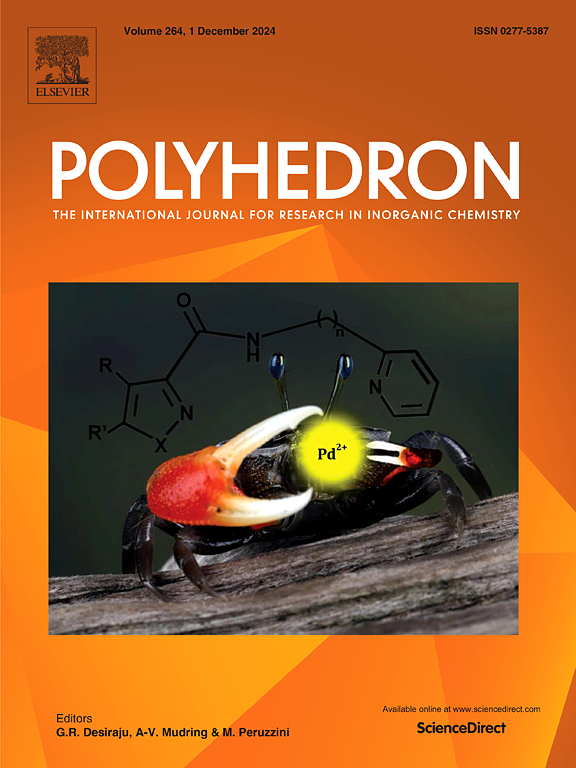Enhanced light and electronic properties of a dihydrate iron(II) sulfate complex with 2,6-diaminopyridinium
IF 2.4
3区 化学
Q2 CHEMISTRY, INORGANIC & NUCLEAR
引用次数: 0
Abstract
A new hybrid complex, (C5H8N3)2[Fe (H2O)6](SO4)2·2H2O, dihydrate of bis (2,6-diaminopyridine) iron (II) sulfate, abbreviated DAPFe, was grown by slow evaporation at room temperature. It crystallizes in the orthorhombic system. The structure consists of [FeII (H2O)6]2+, 2,6-diaminopyridinium cation (C5H8N3)2+, two (SO4)2− anions, and water molecules interconnected through an extensive two-dimensional hydrogen-bond network. The stability of the supramolecular structure was maintained through hydrogen bonding interactions N![]() H…O, O
H…O, O![]() H…O and π…π interactions between the aromatic rings of the 2,6-diaminopyridine units. Hirshfeld surface analysis indicates that, among all possible molecular interactions, the O…H and H…H contacts are predominant, constituting 46.1 and 39.6 % of the total interactions in the crystal lattice, respectively. Thermal analysis (TG-DTA) confirmed the thermal stability of the crystal up to 290 °C. Infrared spectrum was recorded, validating the presence of vibrational modes corresponding to both organic and inorganic groups. Finally, the optical properties were investigated using UV–Vis absorption and photoluminescence spectroscopy, supported TDDFT theoretical calculations.
H…O and π…π interactions between the aromatic rings of the 2,6-diaminopyridine units. Hirshfeld surface analysis indicates that, among all possible molecular interactions, the O…H and H…H contacts are predominant, constituting 46.1 and 39.6 % of the total interactions in the crystal lattice, respectively. Thermal analysis (TG-DTA) confirmed the thermal stability of the crystal up to 290 °C. Infrared spectrum was recorded, validating the presence of vibrational modes corresponding to both organic and inorganic groups. Finally, the optical properties were investigated using UV–Vis absorption and photoluminescence spectroscopy, supported TDDFT theoretical calculations.

求助全文
约1分钟内获得全文
求助全文
来源期刊

Polyhedron
化学-晶体学
CiteScore
4.90
自引率
7.70%
发文量
515
审稿时长
2 months
期刊介绍:
Polyhedron publishes original, fundamental, experimental and theoretical work of the highest quality in all the major areas of inorganic chemistry. This includes synthetic chemistry, coordination chemistry, organometallic chemistry, bioinorganic chemistry, and solid-state and materials chemistry.
Papers should be significant pieces of work, and all new compounds must be appropriately characterized. The inclusion of single-crystal X-ray structural data is strongly encouraged, but papers reporting only the X-ray structure determination of a single compound will usually not be considered. Papers on solid-state or materials chemistry will be expected to have a significant molecular chemistry component (such as the synthesis and characterization of the molecular precursors and/or a systematic study of the use of different precursors or reaction conditions) or demonstrate a cutting-edge application (for example inorganic materials for energy applications). Papers dealing only with stability constants are not considered.
 求助内容:
求助内容: 应助结果提醒方式:
应助结果提醒方式:


